On my India trip exploring the Golden Triangle, I was surprised to discover that so many things that I’d thought were quintessentially British, were actually originally from the Asian country.
India has given us lots: Polo (the sport, not the mint), jodhpurs for horse riding, the board games chess and “Snakes and Ladders”, even the humble button, to name but a few. Though I’ve never watched a Polo match or donned a pair of jodhpurs, I am partial to the odd game of chess, which is believed to have originated in Eastern India in the 6th Century, where it was known as “chaturaṅga”. I guess one of the most well-known (and possibly my favourite) things to come from India, however, is the cuisine.
I love a good “Ruby Murray” as much as the 23 million Brits that regularly consume the dish. Though unlike those with more sensitive palates, for me the spicier, the better. My culinary heaven would be a chicken Vindaloo or Jalfrezzi served with chilli rice, accompanied with side orders of Bombay Aloo, Saag Aloo and a garlic Naan, plus poppadoms to dip in mint sauce and chunky lime pickle (extra hot). My mouth is watering as a type.
So imagine my joy on receiving the itinerary for my India trip in 2016, and seeing that included in the whirlwind 7-day tour was an authentic Indian cookery lesson in Jaipur.
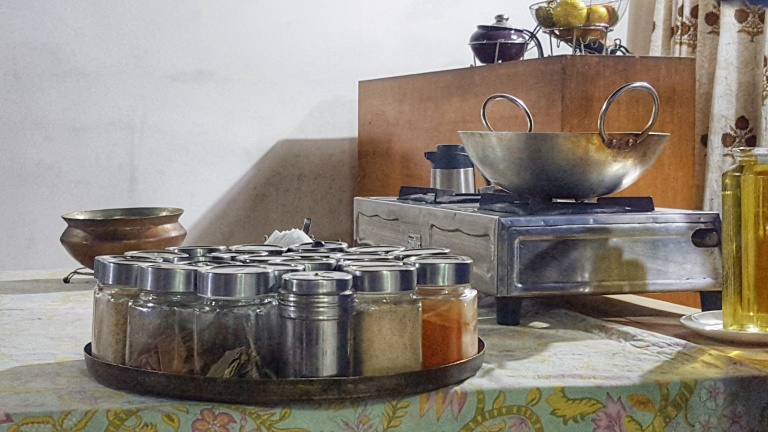
The whole trip was brilliant, and it was fantastic to tick the magnificent Taj Mahal off my bucket list. But the cookery lesson was definitely one of the highlights for me. Here’s a bit more about the experience…
A warm welcome at Nokha House.
On the sixth evening of our trip, after a busy day exploring the “pink city” and the Amer Fort, our little tour group was driven to the outskirts of Jaipur, to Nokha House.
As we clambered off the bus, we were suddenly surrounded by Indians. Nothing unusual about this – it was something we experienced whenever we stepped down from the air-conditioned vehicle or out of the sanctuary of our hotel gates. But unlike the begging, the offers of taxis and the claims of “I give you nice price” that we had – by now – become accustomed to, there was no hustle or bustle or shouting.
Instead, everyone’s wrists were calmly grabbed and tied with a bracelet:

I examined the vibrant red and yellow threads; they were plaited together and knotted with wooden and gold plastic beads, as well as gold flowers and charms. In all the commotion of tying these to our wrists, I couldn’t hear what our tour guide Dilip was saying regarding the bracelet. But consulting my India pocket guide later that evening, I found out that the band is known as “mauli”, and is usually tied on a wrist by Hindus before the beginning of a religious ceremony to invoke the blessings of the Hindu deities. Men have it tied on their right hand, while it’s on the left hand for females – glad they got it on the correct wrist. It’s also believed that the sanctified red thread protects a person from diseases, enemies and other dangers. Perhaps they knew something about my cooking skills…
The women in our tour group were also all dabbed on the forehead with a dye-covered finger. We were adorned with a bindi, a symbolic mark that I previously thought was only given to married women.
Questioning the red dot in between my eyebrows, Dilip explained women from many different religious and cultural communities in India proudly wear bindis. It isn’t just Hindus, but Jains, Sikhs, Buddhists and even Catholics sport the dot. While some believe it’s linked to the third eye (known as “ajna chakra”), a site of wisdom and power said to be situated between the eyebrows, others associate it with married women (though it is also commonly worn by children and single women). Parents may also mark their babies’ faces with bindis to ward off the evil eye.
Both gestures were a great way to get our party into the spirit of the evening, and everyone was excited for what was to come next.
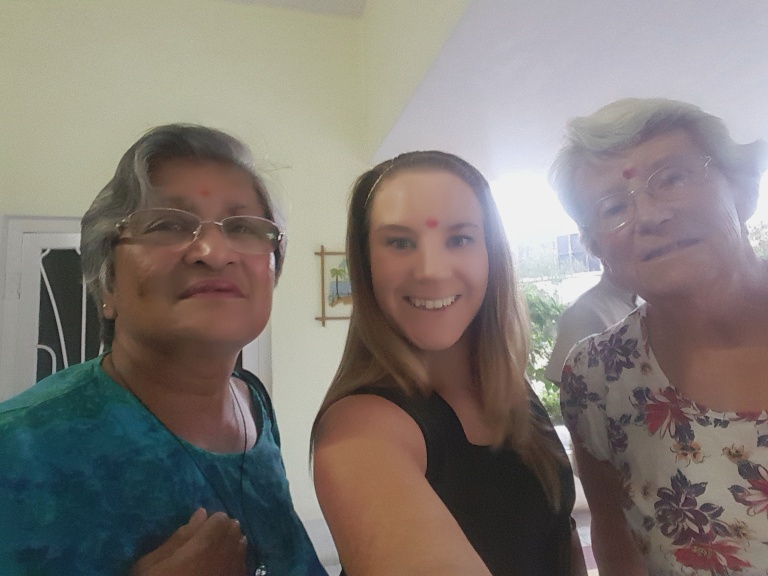
After we’d been marked and our wrists tied (sounds more Fifty Shades of Grey than Can’t Cook, Won’t Cook), Dilip introduced us to the owner of the house, who greeted us by shaking all of our hands warmly. He then ushered us in, giving us a tour of the house at the same time. It was large and spacious, with a large courtyard garden in the middle.
We all took a seat in the garden and chattered away unanimously for a few minutes, before a trolley was pushed out with a refreshing little drink and a hot wash cloth for everyone. One of the owner’s sons then came out, followed in hot pursuit by a very overweight Labrador, who we learnt was called Jaime. The charismatic son gave us a brief history of the house, and what we would be cooking with his parents once we went inside to the dining room. His English accent was remarkable, he could have doubled as Lord Ralph from The Fast Show.
And then, it was time to cook…

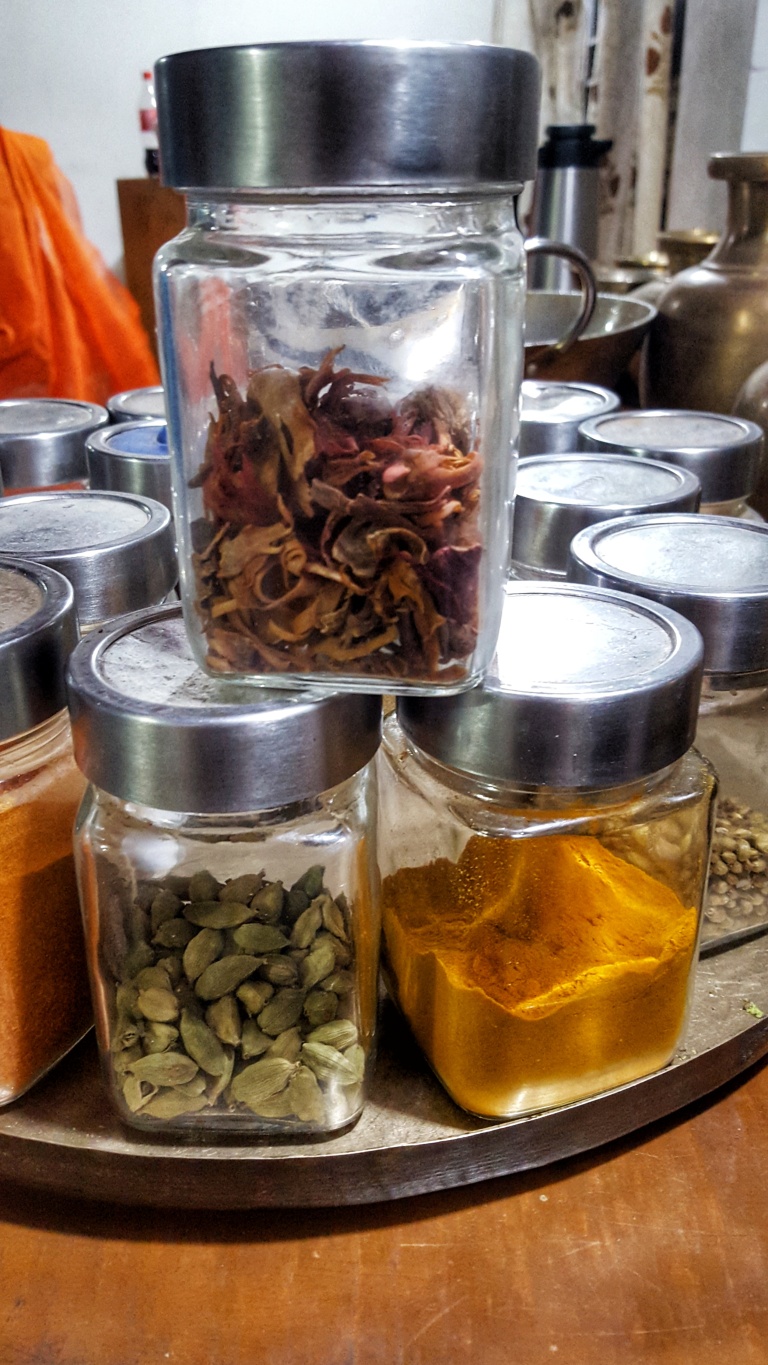
Cooking a curry in India.
Firstly we were introduced to all the spices we’d be using. There were cardamom pods and paprika, cinnamon and mustard seeds. There were things I’d never even heard of before, too, such as garam masala – which we were told was blended from green cardamon pods. Then, we were told what was on the menu for the evening:
- Vegetable pakora
- Green lentil dahl
- Home-made chapatis
Once we’d learnt about the ingredients and what we’d be making, it was time to begin the lesson. Does anyone have any allergies? Yes? Well tough, these Indians didn’t do gluten-free, dairy-free, vegan friendly dishes. This was traditional Indian cookery as it should be.
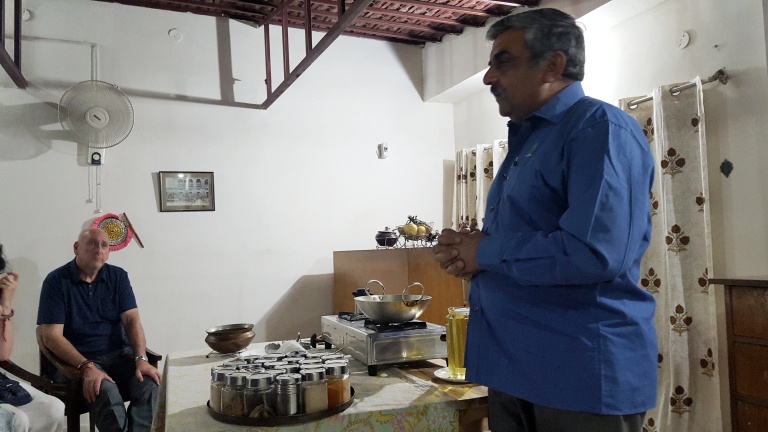
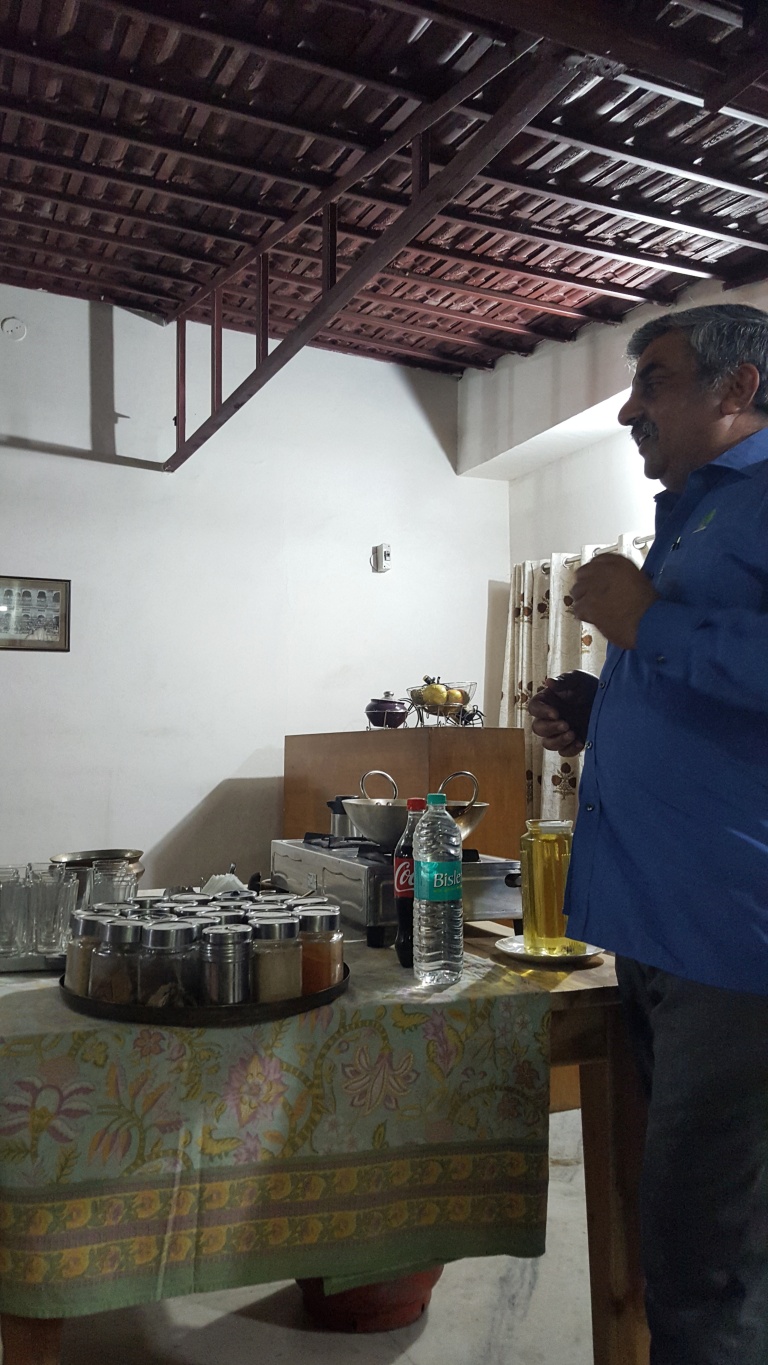
The owner and his wife worked as a tag team, taking it in turns to show us the different techniques and stages for making each part of the meal. I actually managed to video the whole demonstration, so click here if you fancy making your own green lentil dahl.
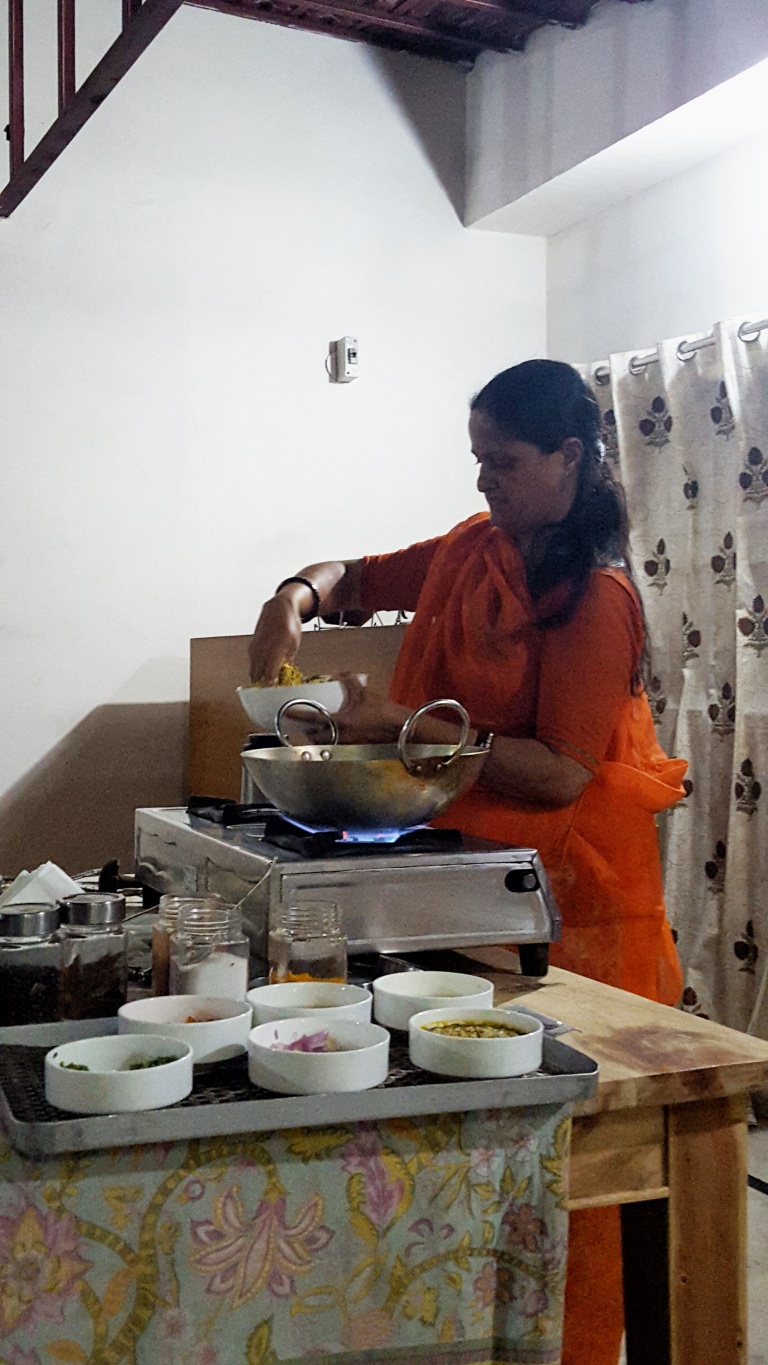

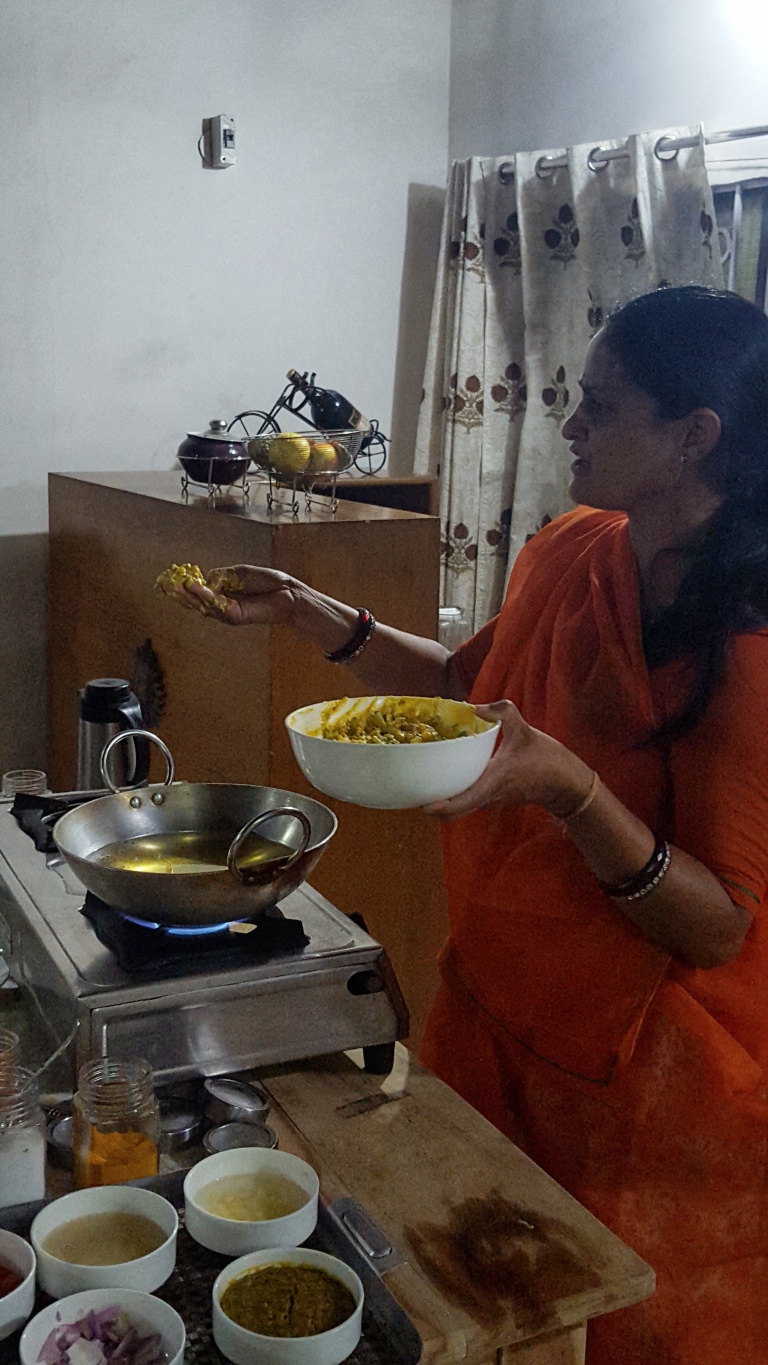
The pakora’s didn’t look that hard to make, though I’ve yet to try them at home.
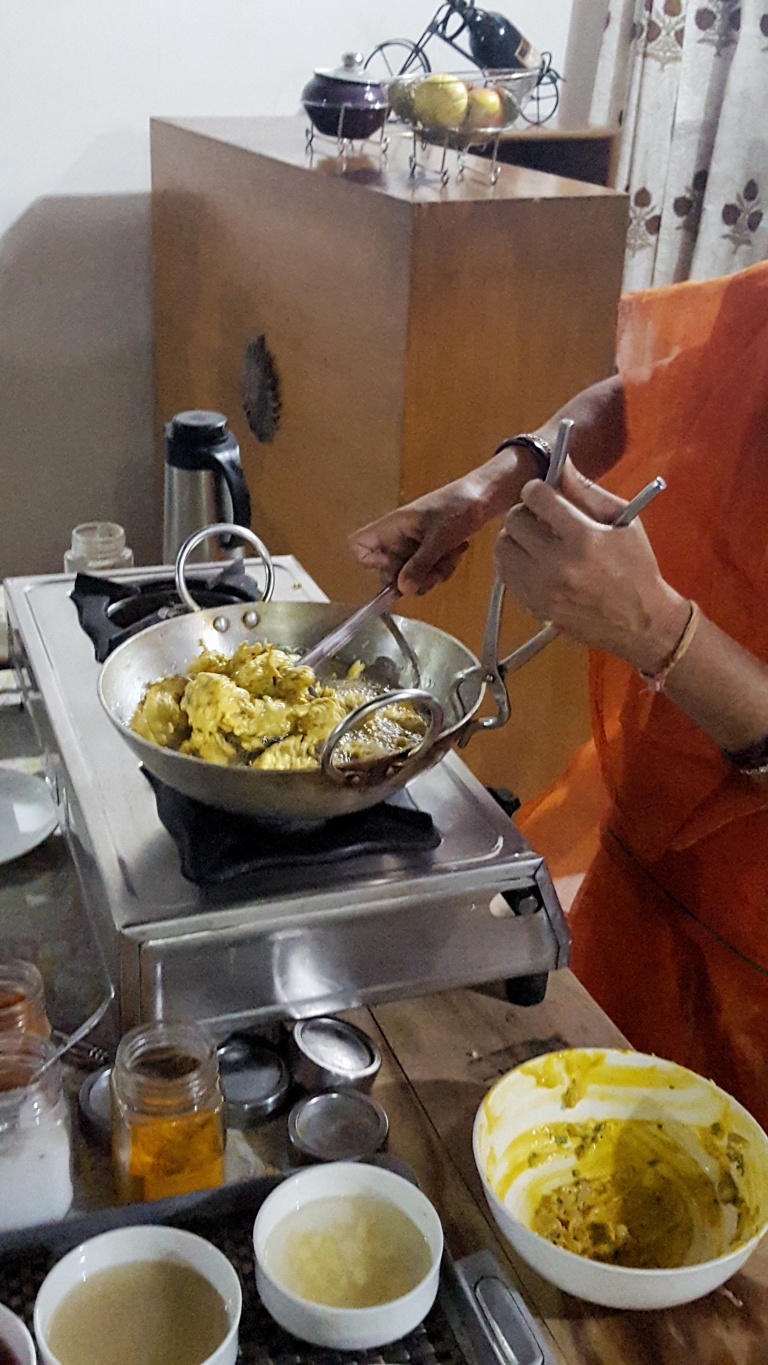
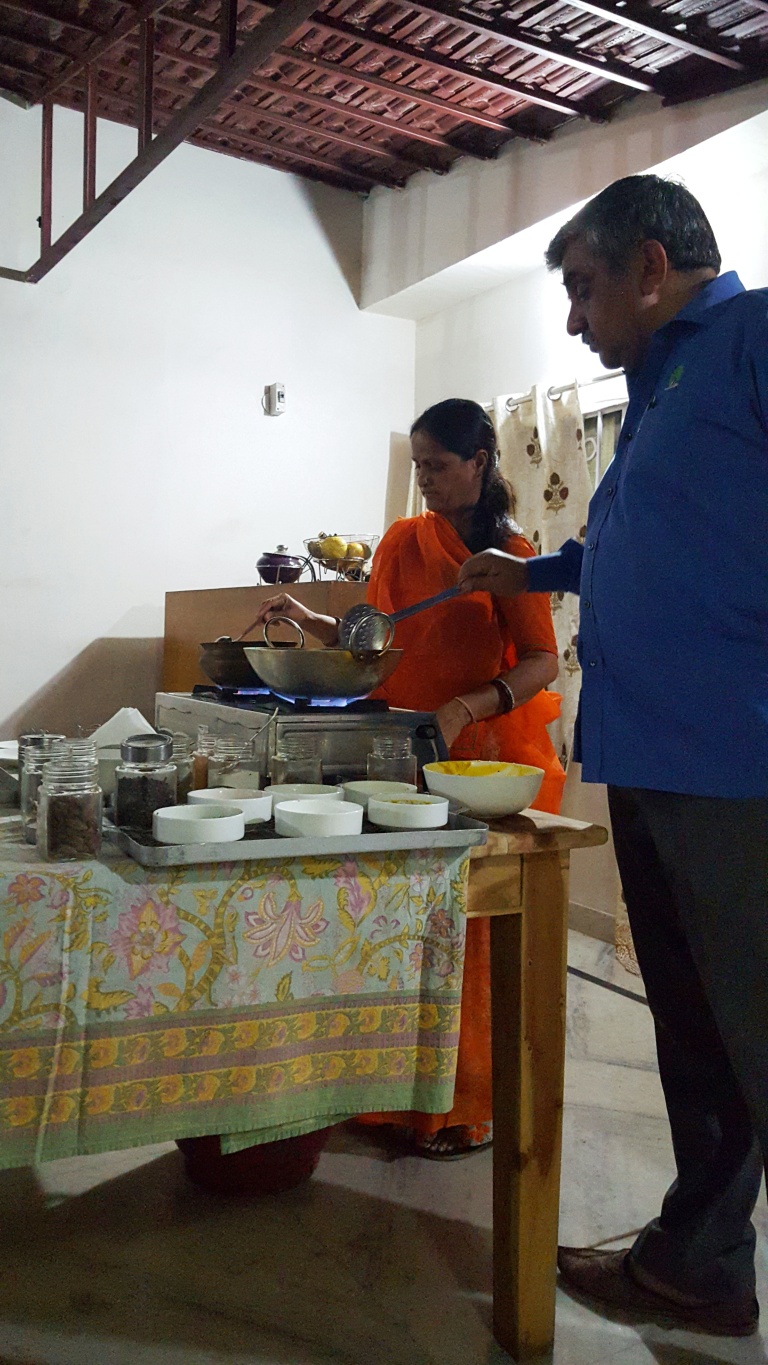
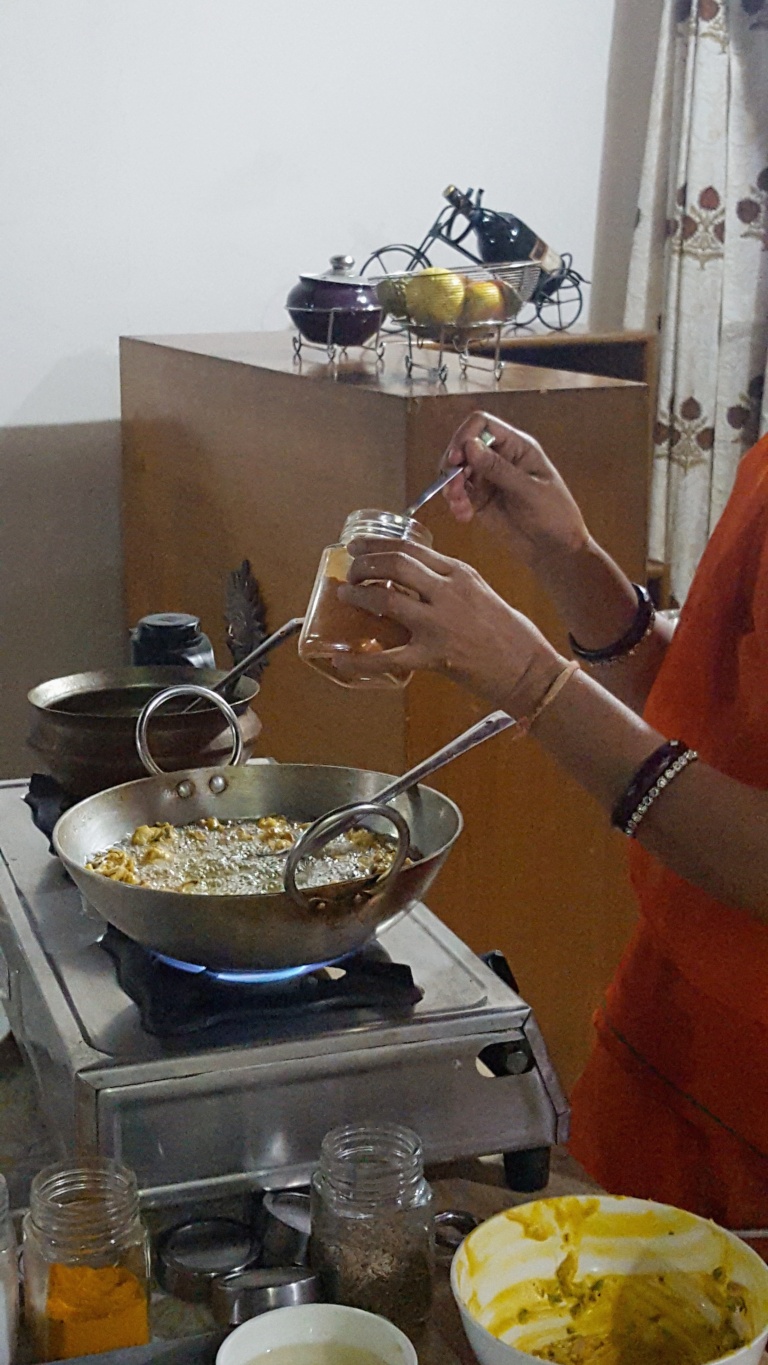

After about 45 minutes, the class was over, though it didn’t feel that long at all. As the owners of Nokha House began clearing up the cooking dishes, we were invited to come up to the front and try some pakora sprinkled with a tasty homemade spice dust. Then, to our dismay, the dahl and chapatis were taken away entirely. “Where are they going? Come back, we’re hungry,” murmured everyone on our tour group, looking around at one another.
A few minutes late, the articulate son, aka Lord Ralph, reappeared in the doorway, with a hungry Jamie at his side. “Ladies and gentlemen, if you could please follow me outside, your dinner is served”.
And so, with tummies rumbling loudly, we all filed back out to the courtyard garden, where little tables had been set-up with candles, glasses, plates and cutlery. The son and Jamie (who could tell he was about to get tidbits from the guests) wheeled out a trolley laden with curries and rice and potatoes and chapatis. All home cooked, all delicious.
*****
If you’re heading to Jaipur and are looking for somewhere comfortable, affordable and hospitable to stay, I cannot recommend Nokha House enough. You can book a room via booking.com. Once there, make sure you take one of their cookery lessons, it’s the only way to learn how to cook authentic Indian cuisine.

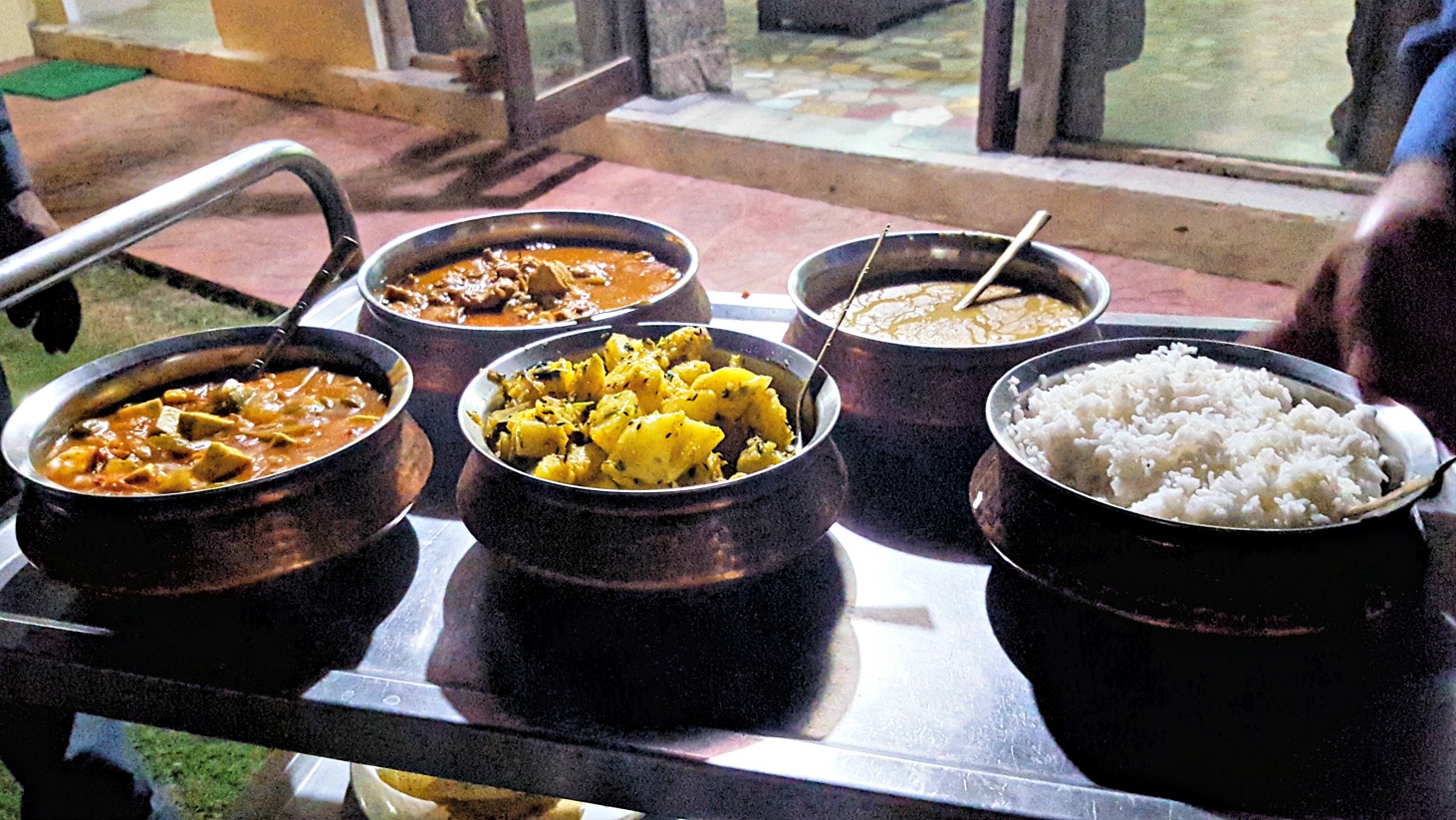
I am sooo glad you enjoyed yourself. Indian food is so vibrant in itself.
The culture is so different in so many parts of the country. And that thread is a very ospicious thread. More like a safe home.
I am just happy you enjoyed being a part of my culture 💖
LikeLiked by 1 person
Ahhh thank you for the lovely comment Sakshi ❤ x
LikeLike
This looks like a fascinating (and delicious) class!! I love me some curry! And I love that you were immersed in the culture before attending the class…talk about an authentic experience!
LikeLiked by 1 person
I know! The introduction to the family, the warm welcome, it was all part of the experience! x
LikeLike
The food looks incredibly delicious! And your cooking class sounds amazing! I bet, must be an overwhelming experience learning an authentic Indian cuisine!
LikeLiked by 1 person
It was a very interesting experience, I learnt a lot! x
LikeLike
I love this cultural post – have learned a lot about what isn’t British! LOL…and also, I’m a BIG fan of Indian food. Aside from already made curries, I’ve yet to cook an Indian dish from scratch, which I am duly putting on bucket list for good measure. Thanks!! xo ❤ Evelyn, PathofPresence.com
LikeLiked by 1 person
I think being able to cook an Indian dish from scratch is an art, and one that I still haven’t mastered, despite the authentic lesson lol. I need more practice 😉 x
LikeLike
Such a fun experience to learn more about Indian cuisine! I’ve always loved their dishes especially since they’re packed with flavor and there are so many variations!
LikeLiked by 1 person
So tasty, aren’t they? x
LikeLike
I’ve actually never tried Indian food. I would love to, but there aren’t many places where I live. I would definitely want a more authentic experience. This sounds like a great experience that I would love to have!
LikeLiked by 1 person
Wow, I can’t believe you’ve never tried Indian food! There are so many places in the UK serving it, though it tastes completely different in India, of course. Hope you get to try it soon, you don’t know what you’re missing 🙂 x
LikeLike
That was very interesting as a cooking class! It was cool you got the opportunity to know more about the ingredients and you even discover new to you ingredients!
LikeLiked by 1 person
Yes, some of the ingredients were completely new to me! x
LikeLike
Wonderful post. I am sharing your post.:)
LikeLiked by 1 person
Wow, this is really insightful. I had no idea so many things came from India either! They’re definitely on my bucket list to visit.
LikeLiked by 1 person
Yeah neither did I – chess was the surprising one for me, I thought it was very British! X
LikeLike
The pictures are everything . I have learned so much in this blog . I wondered a lot about the dot in the middle of the head . I never knew it represented a third eye. Very interesting stuff I could smell the curry cooking through your lines. Nice
LikeLiked by 1 person
Haha I must have written it well if you can smell that 😉 thanks Tesha! x
LikeLike
This is an extremely well written article. Very intresting! Although I eat less spice, I love North Indian foods. And the best part about Indian food is every region and culture and state will have their special taste!!
LikeLiked by 1 person
Yes, you’re absolutely right 🙂 You can also make each dish as spicy or mild as you like x
LikeLike
I honestly don’t know if I’ve ever tried authentic Indian foods before, although I remember walking down my old apartment hallway and smelling it cooking all the time! Lol. This experience that you had is definitely one to be remembered for a lifetime! I would love to visit there and take a cooking class some time!
LikeLiked by 1 person
Haha that smells like my flat – dad calls it “Curry Corridor” because the smells are so strong x
LikeLike
What an experience . Looks like you had fun and oh my how delicious does the food look!
LikeLiked by 1 person
Thanks Kira – the food was amazing! X
LikeLike
Oh my goodness, I have seen a few things this week about Indian cooking lessons and food tours and it all looks and sounds incredible. Food is such an important part of culture and is so often overlooked when travelling. This sounds like such a wonderful experience for you and the photos look fab!
LikeLiked by 1 person
You’re so right Emma – food and meal times are a huge part of the Indian culture. I feel so privileged to have had this kind of cooking lesson! x
LikeLike
I love curry, but I know that I do not know enough about the spices and techniques to cook something authentic. This sounds like a great class and I would happily stay here also
LikeLiked by 1 person
Classes like this are perfect if you want to learn some authentic skills and techniques for cooking curries 🙂 have you ever done any cookery classes while overseas Zena? X
LikeLike
Wow, that must have been utterly incredible! I had a cookery lesson is Sri Lanka and it remains one of my favourite holiday events ever x
LikeLiked by 1 person
Oh wow, I bet that was amazing! I haven’t been to Sri Lanka yet, but it’s on the list 😉 x
LikeLike
I’ve never been to India before. I would love a cooking lesson from them. I think I’d love all the various spices!
LikeLiked by 1 person
Do you think you’d ever travel to India? Because I’d definitely recommend my trip if you’re considering it in the future 🙂 x
LikeLike
I’d have a blast with the Indian cookery lesson. I love stuff like that. If I have the opportunity to ever go, I’ll check out Nokha House.
LikeLiked by 1 person
I hope you get the opportunity at some point Terri – it’s a great experience! x
LikeLike
I love Indian food and cooking so this would be right up my alley and would really enjoy having a cooking lesson. Hopefully to visit there one day.
LikeLiked by 1 person
This looks great! I am actually a huge fan of Curry! I’d love to learn how to cook it myself!
LikeLiked by 1 person
Do you like your curries super hot Jessica, like me – or a bit milder? x
LikeLike
I’ve actually never had Indian food before but it sounds so yummy!
LikeLiked by 1 person
Oh my goodness, you must try it soon! x
LikeLike
This looks fun! I had no idea Polo came from India!
LikeLiked by 1 person
Neither did I!! x
LikeLiked by 1 person
Oh wow I bet this was an amazing way to experience I piece of India. The food sounds amazing as well.
LikeLiked by 1 person
It was soooo tasty – maybe could have done with a few extra chilies though 😉 x
LikeLike
That food looks like it would be amazing. I would love the chance to experience any India culture that I could!
LikeLiked by 1 person
Have you ever been to India? x
LikeLike
What a wonderful experience! I bet you’ll be making some interesting dishes when you return home!
LikeLiked by 1 person
Yes, most definitely 🙂 I love cooking! x
LikeLike
Indian food is so yummy. my old flatmate was indian and she used to make us the most delious food ever,whenever i helped prepare the food, it took forever,but the results were worth it.
LikeLiked by 1 person
Yeah, if you’re cooking from scratch it is quite lengthy, but it always tastes sooooo much better, right? x
LikeLike
Looks like you had a great time. I’m loving the cooking class and that bracelet. It’s always good to know what it means and that you got it put on correctly.
LikeLiked by 1 person
Hehe yes it is! I loved that bracelet, though sadly after a few showers it got a bit lose and grotty, so I had to take it off 😦 x
LikeLike
Wow! This is an amazing side of Indian culture that you are showing. I love Indian food so much specially biryani with buttered chicken. Great post!
LikeLiked by 1 person
Ohhh yes, I like a biryani too – you’ve got me hungry now! x
LikeLike
This is such an amazing experience. I love Indian food and culture. Thanks for sharing.
LikeLiked by 1 person
Have you ever been to India Ophelia? x
LikeLike
I LOVE curry! Looks like an amazing experience! Thanks for sharing! 😊
LikeLiked by 1 person
It was such a fun thing to do on my trip 🙂 especially as I love curry too! X
LikeLiked by 1 person
OMG what an amazing food experience! I bet it was amazing!
LikeLiked by 1 person
It was so much fun! X
LikeLike
What a fantastic way to visit this lovely country than learning an authentic Indian cookery lesson in Jaipur. I am not so familiar with all the spices too. Good to hear you enjoyed your adventure there.
LikeLiked by 1 person
It was definitely a good way to experience a new culture x
LikeLike
Jaipur is a food lovers paradise. And what better way to eat your way through to learn about the culture and ideologies of a country. I’d love to take cooking lessons as well because I love cooking and green lentil is infact my one of the favorites.
LikeLiked by 1 person
It was a great introduction to Indian cusine x
LikeLike
What a cool experience! I LOVE Indian food though I don’t think I could eat it quite as spicy as you do. 🙂 It was a nice touch for them to tie on the bracelets and add the bindi. I think I would have to stay here and take a cooking class if I ever go to India! Great review
LikeLiked by 1 person
Yeah, the bindi and bracelets were a great touch x
LikeLike
I am a real fan of Indian food but guess that the stuff we have here suits our pallet so would love to try some authentic stuff.
LikeLiked by 1 person
Authentic is definitely best in my experience 😀 x
LikeLike
I’ve always wanted to visit India! Such a beautiful place. And that food looks amazing!
LikeLiked by 1 person
It is a fascinating country ❤ x
LikeLike
That looks like a great experience. I always wanted to visit India and try their special food and their spices. and your bracelet is so adorable. I love it.
LikeLiked by 1 person
Yes, India was on my bucket list for soooooooo long! It was such an amazing trip x
LikeLike
The cookery lesson sounds amazing. I love learning with new food and I absolutely adore Indian food!
LikeLiked by 1 person
Love this post! I think I might just book Nokha House for my trip next month. Would love to learn about cooking a proper Indian cuisine.
LikeLiked by 1 person
Oh, I love a good curry! I can’t handle spice at all though since I have a baby mouth.
LikeLiked by 1 person
For me, the spicier the better! X
LikeLike
Oh wow I never knew chess originated in India. That’s one way to learn how to make authentic Indian food I bet it was great to see it live. I do like to see chefs / home cooks in action. I do like Indian food especially dal x
LikeLiked by 1 person
The tour sounds fantastic! I love any food that is spicy or chili so Indian is definitely one of my favourites, theflavours are to die for!
LikeLiked by 1 person
You sound just like me Adriana x
LikeLike
Taking local cooking lessons is one of the best ways to understand the local culture – this is how I feel about it at least! Especially it concerns India – a country, where food is a cult, and where every province, city, village have a speciality of their own … pictures of the spices from your class made me almost taste the dishes in my mouth ))
LikeLiked by 1 person
Thanks for your comment Alina – I think you’ve summed my post up brilliantly. Taking a cookery lesson in a foreign country really gives you a flavour for the culture, as well as the food 😉 x
LikeLike
I do love taking cooking classes when I travel. I haven’t though tried any in India, as every time I went there my schedule was full. However, Indian is 0ne of my favorite foods and I’d love to try and discover some of the secrets of the spices used.
LikeLiked by 1 person
Next time Joanna, next time 😉 x
LikeLike
I would LOVE to attend a class like this. Indian food is some of the best on the planet, and learning how to make it would be so much fun!
LikeLiked by 1 person
To be so close and see Indian food being cooked in the traditional manner must have been such a delight 🙂
LikeLiked by 1 person
This is beyond cool. Can I just tell you how much I love Indian Food. We have a chain restaurant and one that my husband and I frequent that is authentic and run by natives. How amazing to get the opportunity to see how this delicious food is actually prepared!
LikeLike
My husband has Indian blood and I couldn’t agree more when it comes to the cooking skills. The food is always great and the smell of spices is mouthwatering. Thanks for sharing this!
LikeLiked by 1 person
A trip to Jaipur (or anywhere in Rajasthan) is not complete without digging into authentic Rajasthani food. Whether you’re craving dal bati churma, laal maas, kachoris or ghevar, Jaipur is foodie’s paradise.
LikeLiked by 1 person
How fun! I love when you can find authentic activities to learn about other cultures
LikeLiked by 1 person
its great you had the opportunity to experience a local cooking class! i bet it was amazing!
LikeLiked by 1 person
I really enjoyed reading this post. I am glad that you enjoyed learning to cook an Indian cuisine and the food looks really delicious.
LikeLiked by 1 person
Sounds like such an amazing experience! I am a huge foodie so this would be right up my alley, learning about spices and how to cook Indian food.
LikeLiked by 1 person
I have never had Indian food! I would love to try some.
LikeLiked by 1 person
What a fantastic experience and you are really learning from the experts! We love to learn authentic Indian cookery. I bet the smells and spices were amazing!
LikeLiked by 1 person
I love Indian food, especially their desserts. You did a great job! 🙂
LikeLiked by 1 person